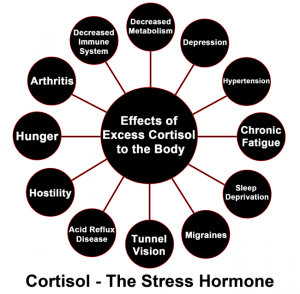Guest writer for Wake Up World
The body knows how to heal itself. As I describe in my book Mind Over Medicine: Scientific Proof That You Can Heal Yourself, our bodies are beautifully equipped with natural self-repair mechanisms that fight cancer, prevent infection, repair wounds, protect us from infectious agents and foreign bodies, and even affect how our genes express themselves! But here’s what most people don’t know. These natural self-repair mechanisms get deactivated when your body is full of stress hormones like cortisol and epinephrine in “fight-or-flight” mode.
Makes sense. When your amygdala, the not-so-smart part of your brain that reacts to threats by tripping off the “fight-or-flight” stress response, signals the warning alarm, your body focuses all its attention on fighting and fleeing. Blood flow is shunted to your large muscle groups, your heart rate increases, your blood pressure goes up, and your body is on red alert. When your amygdala thinks you’re about to get eaten by a mountain lion, the body isn’t worried about preventive maintenance and the body’s self-repair operations halt until the threat is over.
But in modern day life, our warning alarms are ringing at least 50 times per day, flooding our bodies with cortisol and putting us at risk of illness. Your amygdala can’t tell the difference between a real threat to life and limb, like getting chased by a mountain lion, and a perceived threat, like fear of losing your job, worry that your loved one will leave you, or even anger that someone spilled red wine on your white carpet.
(Are you at risk? Check out my recent article, 10 Signs That You Have WAY Too Much Cortisol.)
The good news is that it’s easy to shift the body into the opposite of the stress response into the relaxation response, and when this happens, your cortisol levels drop and your body’s self-repair mechanisms get back to work doing what they do best – healing you. All of the following techniques have been scientifically proven to activate relaxation responses and return your self-repair mechanisms back to optimal operation.
10 Fun Ways To Reduce Cortisol Levels
1. Meditate.
Harvard physician Herbert Benson extensively studied a form of Transcendental Meditation proven to activate the relaxation response and improve dozens of health conditions ranging from heart disease to diabetes to obesity to cancer. All forms of meditation activate the relaxation response, but if you find it hard to sit in silence, try downloading the free Self-Healing Kit I created, which comes equipped with a self-healing guided meditation known to activate the relaxation response at MindOverMedicineBook.com.
2. Laugh more!
In his bestselling book The Anatomy Of An Illness, Norman Cousins tells the story of how he cured himself from the debilitating condition ankylosing spondylitis by laughing along with Marx Brothers movies. He wrote, “I made the joyous discovery that ten minutes of genuine belly laughter had an anesthetic effect and would give me at least two hours of pain-free sleep. When the pain-killing effect of the laughter wore off, we would switch on the motion picture projector again and not infrequently, it would lead to another pain-free interval.”
3. Play with animals.
Snuggling with our pets fills us with oxytocin, endorphins, and other healing hormones that support the body’s self-healing mechanisms. This is why pet therapy can be so effective, both mentally and physically. So go cuddle Fido, rub Fifi’s belly, and let them cut your cortisol levels while ramping up your body’s capacity to self-repair.
4. Give generously.
When Cami Walker was diagnosed with debilitating multiple sclerosis, conventional medicine had very little to offer. Then a South African medicine woman suggested that, instead of focusing on herself, she needed to shift towards thinking more about others. The medicine woman wrote Cami a prescription – Give 29 gifts in 29 days. So she did. And as if by magic, her MS symptoms started to diminish. How? Because giving activates relaxation responses, which bolster the body’s natural self-repair mechanisms.
Andy Mackey enjoyed similar health benefits from giving generously. After 9 heart surgeries, Andy’s doctors had him on 15 medications, but the side effects made him miserable. So he decided to stop all his medications and spend his remaining days feeling as good as he could. His doctors said he would die within a year, so Andy decided to do something he had always wanted to do. He decided to use the money he would have spent on his heart medicines to buy 300 harmonicas for children, with lessons. And when he didn’t die the next month, he bought a few hundred more. It’s now 11 years and 16,000 harmonicas later and Andy Mackey is still giving generously.
5. Express yourself creatively.
Creative expression releases endorphins and other feel-good neurotransmitters, reduces depression and anxiety, improves your immune function, relieves physical pain ,and activates the parasympathetic nervous system, thereby lowering your heart rate, decreasing your blood pressure, slowing down your breathing, and lowering cortisol.
6. Practice yoga, tai chi, Qigong, or dance forms like Gabrielle Roth’s 5 Rhythms – or get a massage.
All of these modalities, which combine the benefits of exercise and meditation, steep you in healing hormones and have been proven to effectively drop cortisol levels and improve your body’s ability to heal itself.
Or get a massage, the ultimate relaxation response activator. A nurturing massage not only relaxes your muscles, it relaxes your nervous system and kicks those self-healing mechanisms into high gear.
7. Get it on.
Those with healthy sex lives live longer, have a lower risk of heart disease and stroke, get less breast cancer, enjoy the benefits of stronger immune systems, sleep better, appear more youthful, enjoy improved fitness, have enhanced fertility, get relief from chronic pain, experience fewer migraines, suffer from less depression, and enjoy an improved quality of life. Oh – and their cortisol levels are lower!
8. Pray or attend services as part of a spiritual community.
Those who attend religious services live up to 14 years longer than those who don’t, but don’t go to church if it’s not in alignment with your authentic beliefs. Find – or create – your own spiritual tribe, and enjoy the hormonal benefits of gathering together with the intention of loving, healing, and lifting the vibration of each other and the planet. Your nervous system – and your body – will thank you.
9. Alleviate your loneliness.
Lonely people have twice the rate of heart disease as people who aren’t lonely. In fact, loneliness researchers suggest that alleviating your loneliness is more important to a healthy lifestyle than quitting smoking or starting to exercise. (Read more in How To Stay Healthy Even If You Eat Junk, Smoke Ciggies, Skip Exercise & Booze It Up. As Robert Putnam put it in Bowling Alone, “As a rough rule of thumb, if you belong to no groups but decide to join one, you cut your risk of dying over the next year in half. If you smoke and belong to no groups, it’s a toss-up statistically whether you should stop smoking or start joining. These findings are in some way heartening. It’s easier to join a group than to lose weight, exercise regularly, or quit smoking.”
10. Be brave enough to take radical action in order to reduce your stress responses.
Ask yourself, “What does my body need in order to heal?” If your intuition says, “You have to quit that soul-sucking job” or “You’ve got to get out of that abusive relationship,” listen up. You’ve just written The Prescription for yourself. (To learn more about how to write The Prescription for yourself, read Mind Over Medicine.
Too scared to take a leap of faith? As my friend and co-conspirator at the Whole Health Medicine Institute says, “If you want big miracles, you have to take big risks. If you’re wanting to take smaller risks, you’ll have to accept smaller miracles.”
When You Make So Much Cortisol That You Lose It
Keep in mind that, when I’m talking about dropping your cortisol levels, I’m not talking about depleting your adrenal glands altogether. When we’re stressed, cortisol levels tend to run high – but over time, your adrenal glands can become fatigued, and the overstress leads your cortisol levels to drop.
The goal is the three bears approach to cortisol. You want your levels to be not too high, not too low, but just right.
What Will You Do To Bring Your Cortisol Levels Into Balance?
Tell us in the comments below.
With love and “Om’s,”
Previous articles by Lissa
- 8 Ways Overcoming Fear Can Improve Your Health
- 6 Stories To Make You Believe In The Power Of The Mind To Heal You
-
6 More Stories To Make You Believe In The Power Of The Mind To Heal You
- Why Engaging In Work You Love Could Save Your Life
- The Health Benefits Of Finding Your Tribe
- 7 Tips For Finding Your Tribe
- 10 Signs You’ve Found Your Calling
About the author
 Lissa Rankin, MD is a mind-body medicine physician, founder of the Whole Health Medicine Institute training program for physicians and health care providers, and the New York Times bestselling author of Mind Over Medicine: Scientific Proof That You Can Heal Yourself. She is on a grass roots mission to heal health care, while empowering you to heal yourself.
Lissa Rankin, MD is a mind-body medicine physician, founder of the Whole Health Medicine Institute training program for physicians and health care providers, and the New York Times bestselling author of Mind Over Medicine: Scientific Proof That You Can Heal Yourself. She is on a grass roots mission to heal health care, while empowering you to heal yourself.
Lissa blogs at LissaRankin.com and also created two online communities – HealHealthCareNow.com and OwningPink.com. She is also the author of two other books, a professional artist, an amateur ski bum, and an avid hiker. Lissa lives in the San Francisco Bay area with her husband and daughter.

If you've ever found value in our articles, we'd greatly appreciate your support by purchasing Mindful Meditation Techniques for Kids - A Practical Guide for Adults to Empower Kids with the Gift of Inner Peace and Resilience for Life.
In the spirit of mindfulness, we encourage you to choose the paperback version. Delve into its pages away from screen glare and notifications, allowing yourself to fully immerse in the transformative practices within. The physical book enriches the learning process and serves as a tangible commitment to mindfulness, easily shared among family and friends.
Over the past few years, Wake Up World has faced significant online censorship, impacting our financial ability to stay online. Instead of soliciting donations, we're exploring win-win solutions with our readers to remain financially viable. Moving into book publishing, we hope to secure ongoing funds to continue our mission. With over 8,500 articles published in the past 13 years, we are committed to keeping our content free and accessible to everyone, without resorting to a paywall.








